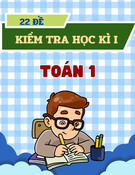
A. LISTENING. (30 points)
I. Listen to a radio programme about two explorers. For questions 1-5, decide if the following sentences are
True (T) or False (F). (10 points)
No.
Questions
True
False
1
Social conventions made it difficult for Ida Laura Pfieffer to travel.
2
She was accidentally involved in attempt to overthrow a government.
3
Mary Kingsley began exploring with her parents.
4
She could easily have died when she fell into a hole.
5
Her descriptions of African culture are very similar to those in Joseph Conrad's Heart
of Darkness.
II. You will hear a writer talking about a book she has just written on the subject of aspirin. For questions 6-
13, complete the sentences. (8 points)
THE STORY OF ASPIRIN
Doctors in (6)______________ treated their patients with a medicine derived from the bark of the willow.
Edward Stone believed that (7) ______________ was similar to quinine.
The active ingredient of aspirin was isolated in (8) ______________.
Unfortunately, salicylic acid can affect the (9) ______________ quite badly.
The first commercially available aspirins were made by Bayer, a ______________ (10)
However, there was little (11) ______________ into the way aspirin works for nearly 70 years.
SỞ GD & ĐT HẢI DƯƠNG
TRƯỜNG THPT CHUYÊN
NGUYỄN TRÃI
ĐỀ THI NĂNG KHIẾU LẦN THỨ NHẤT
MÔN: ANH
LỚP 11
Ngày thi: 05/10/2020
Thời gian làm bài: 180 phút
(Học sinh làm bài vào phiếu trả lời)

Some scientists think that people over (12) ______________ should take aspirin to prevent certain
diseases.
It appears that (13) ______________ grown without artificial chemicals also contain the active Ingredients
of aspirin.
III. You will hear parts of a lecture about the film director Alfred Hitchcock. Choose the correct letter A, B or
C (12 points)
14. Why did Hitchcock want the camera to move in a particular way?
A. It meant that scenes could be filmed more quickly.
B. It changed the way the viewer followed the action.
C. It was what viewers expected.
15. What does the lecturer say about the filming of the shower scene in Psychol?
A. Hitchcock was wasting valuable time.
B. Today’s filmgoers are not interested in such detail.
C. Spending a week filming one scene would now be too expensive.
16. Which of the following statements about Hitchcock’s movies is NOT true?
A. The viewer is left to imagine many of the actual murders.
B. The real aim is to expose his characters’ inner thoughts.
C. It is easy to guess the ending of a Hitchcock film.
17. According to the lecturer, viewers of Psycho identify with the murderer because _______?
A. the character they initially relate to is dead.
B. he is a likeable character.
C. the other characters are not very interesting.
18. The lecturer believes that before Hitchcock ____________.
A. directors always acted in their own films.
B. directors did not play such an important role in film-making.
C. people knew what the director looked like.
19. What is the main theme of the lecture?

A. the movie Psycho
B. a comparison of various Hitchcock movies
C. Hitchcock’s contribution to cinema
B. LEXICO AND GRAMMAR. (50 points)
I. Choose the best answer for each question. (10 points)
1. You must be prepared to _____ yourself to greater stress if you take on a second job.
A. offer B. subject C. field D. place
2. To begin studying chemistry at this level, you must already have proved your ability in a related _____.
A. line B. discipline C. region D. rule
3. There was considerable doubt _____ exactly who was responsible for the accident.
A. out of B. as to C. as for D. for
4. Their plan was out of this _____ but unfortunately the outcome was not so impressive.
A. moon B. planet C. world D. earth
5. All candidates will be treated equally, _____ of their age or background.
A. notwithstanding B. discounting C. irrelevant D. irrespective
6. If you come to the theatre late, you have to wait until the ____ to get in.
A. break B. interval C. refreshment D. half-time
7. The fog was so thick that we could not ____ the oncoming car.
A. get on B. make out C. see through D. watch out
8. I read the contract again and again _____ avoiding making spelling mistakes.
A. with a view to B. in view of C. by means of D. in terms of
9. The two naughty boys were ____ after school for misbehavior.
A. detained B. withheld C. postponed D. stayed
10. My teacher wanted to see me _____ to discuss some class problems.
A. by person B. as a person C. in person D. with person
II. Supply the correct form of the words given in brackets to complete each of the sentences below. Write
your answer in the space provided. (10 points)
1. They lost the battle, despite (number) ___________________ the enemy by two to one.
2. Before enrolling on a course, check that it has been (valid) ___________________ by a reliable
organizer.

3. We could hardly talk on deck because of the (deaf) ___________________ roar of the sea.
4. How are you getting on with your (correspond) ___________________ course in French?
5. Our efforts to make him change his mind proved (fruit) ___________________; he wouldn’t listen.
6. There is not much (clear) ____________________ for tall vehicles passing under this bridge.
7. She is very efficient, and (fail) ___________________ polite to the customers.
8. The slight (form) ___________________ in his chin was corrected by surgery.
9. I had to stand in terrible (comfort) ___________________ on the crowded bus for half an hour.
10. This is an extremely difficult job for young and (experience) ___________________ people.
III. Fill each gap in the following sentences with a suitable preposition or adverb particle. (10 points)
1. The boss cannot account ____________ all the money he has spent?
2. The explanation the teacher gave is quite ____________ us.
3. They bought the house last year and have sold it ____________ a profit.
4. Many stars are invisible ____________ the naked eyes, so they need a telescope.
5. Normally, virus diseases will clear up _____________ their own accord.
6. The senator is believed to be implicated _____________ the scandal.
7. Bill is practicing very hard. He is intent _____________ winning a gold medal.
8. Strangely enough, the baby doesn’t take _____________ their parents at all.
9. I will soon send you a letter _____________ confirmation of our plan.
10. The police are looking _____________ the past record of the suspect.
IV. Identify one of the four underlined parts in each sentence which is incorrect and get it right. Write your
choice A, B, C, or D and the corrections in the space provided. (20 points)
1. So far Margaret (A)has been writing 5 novels (B)on the problems (C)teenagers have to (D)cope with in
modern times.
2. (A)Frequent exposure to (B)intense noise pollution can (C)damage a person’s (D)hear temporarily or
permanently.
3. Tom’s grandfather left (A)him 50,000 (B)dollars, (C)this was (D)too big a sum for him.
4. You (A)mustn’t have seen Peter, (B)for he went (C)abroad two years ago and now (D)lives in Australia.
5. (A)Every chemical (B)has a standard symbol (C)which is found in the (D)period table of elements.

6. Most educators today (A)consider computer literacy (B)being a (C)necessary addition to the (D)basic
scholastic requirements.
7. A ray of light passing (A)through (B)the center of a thin lens (C)keeps its (D)origin direction.
8. Experiments (A)have shown that (B)the bees can (C)somehow sense the Earth's (D)magnetic field.
9. (A)Millions of dollars’ (B)worth of plants are (C)raised (D)annual in greenhouses.
10. There (A)is not way by which the peoples of (B)the world can be (C)divided into neat and precise
(D)racial categories.
C. READING. (60 points)
I. Read the text below and think of the word which best fits each space. Use only ONE word in each space.
Write your answers in the corresponding numbered boxes. (20 points)
Child Custody
A century ago, fathers who fought in court for custody of their children usually (1) ___________, simply
because they were the breadwinners. Early in this century, women began persuading judges that (2)
___________ were better suited to child-rearing, and courts (3) ___________ awarding them custody and
child support payments. As one judge (4) ___________ in 1921, “for a youngster of tender years (5)
___________can be an adequate substitute (6) ___________ mother love.”
Most judges today still hold to this standard. Each (7) ___________ courts determine the fate of some
100,000 children of divorce and, in nine (8) ___________ of ten cases, the mother gets (9) ___________.
Another 900,000 children a year are similarly dispersed out of court. (10) ___________, there is now a
growing belief that mothers aren’t necessarily the (11) ___________ parents after a divorce. Neither (12)
___________ fathers.
A new arrangement has (13) ___________ evolving, mostly in private divorce settlements, known (14)
___________ joint custody. The parents agree to (15) ___________ equally in important decisions
regarding their (16) ___________, and to share fairly, though not always equally, in their physical care. A
(17) ___________ state legislatures have authorized joint custody if judges (18) ___________ it in a few
best interest. In other states, like New York, judges have (19) ___________ joint custody awards without
requiring special (20) ___________
II. Read the following passage and circle the best answer for each blank. Write your answer (A, B, C or D) in
the box provided. (10 points)












![Đề thi Tiếng Anh có đáp án [kèm lời giải chi tiết]](https://cdn.tailieu.vn/images/document/thumbnail/2025/20250810/duykpmg/135x160/64731754886819.jpg)



